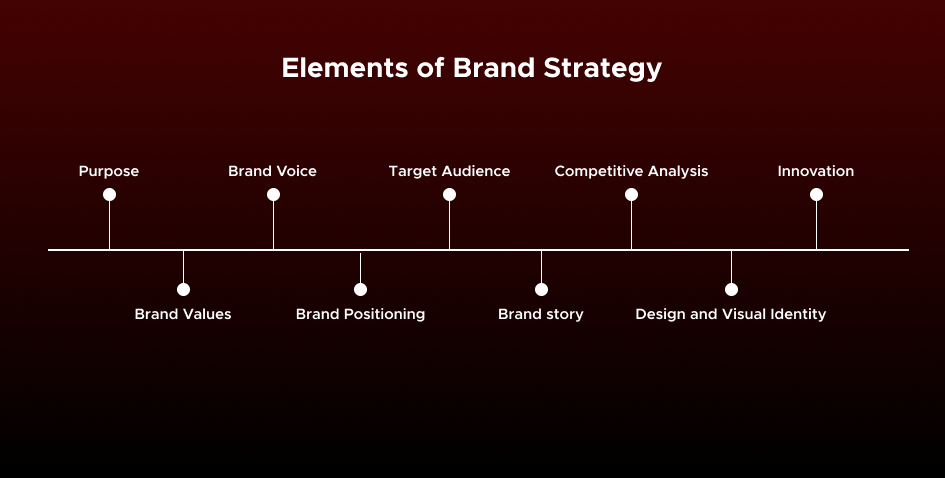
What are the basic steps you should follow to increase your brand strategy?
Published

July 8, 2025

16 min read


July 8, 2025

16 min read

You might hate business branding; however, it matters. Everyone talks about corporate branding strategy, yet few follow basic, powerful steps. Nowadays, a decent product or service is no longer enough to ensure success due to the high competition in the market. You need a strong brand strategy for your business to stand out in a crowded market, establish a genuine connection with your target audience, and ensure that customers remember you for a long time through effective marketing strategies. This shows the importance of brand strategy for your long-term successful business.
Branding helps you build trust, balance, urgency, creativity, power and optimism. Moreover, branding is beyond just picking a logo, choosing some bright colors and picking a tagline. Instead, it’s about setting clear goals with consistency and clarity to enhance your digital presence. You might be the best seller out there in the market; nevertheless, it won’t matter if people don’t know about your existence. Branding is a bridge between your offerings, opportunities and skills. You should build genuine connections and form strong emotional bonds with your target audience.
In this guide, we will discuss branding strategies, their importance, key elements, and 14 proven steps to enhance your brand strategy. This will enable you to promote your brand and fulfil customer promises effectively.
A brand strategy is a long-term plan that outlines how a company will utilize consistent branding to achieve its primary objectives. It tells you what the business does, what it says, and what it looks like. Essentially, it’s like a detailed plan for building a brand personality that’s unique and easy to remember. On the other hand, short-term marketing, on the other hand, focuses on achieving immediate objectives, such as sales or advertising. In contrast, a brand strategy helps you succeed in the long run and stay relevant in the market.

The primary purpose of a brand strategy is to give your company a personality that people can relate to through engaging stories, clear values, distinctive imagery, and a clear mission. Without a defined brand strategy, marketing initiatives can become disorganized and ineffective. This could lead people to lose faith in the brand and stop recognizing it. Therefore, for a firm to succeed, it must consistently employ the same marketing strategies. This ensures that marketing funds are used effectively and have a positive impact.
In 2025, your business needs a clear brand strategy to stay competitive and grow. The factors that will make your business stand out are the unique branding plan. Furthermore, this plan will allow your business to showcase what makes you distinctive and attract new customers. Importantly, when people form an emotional connection to a brand, they are more likely to remain loyal to it.
This is why clever branding in Abu Dhabi is crucial for fostering loyalty and trust. Nevertheless, your message and images must be consistent everywhere your brand is seen and heard. This will build trust and make the brand easier to remember. A well-thought-out brand plan helps a company grow gradually and increase sales by allowing it to compete on value rather than price.

Carefully craft your business’s core elements to create a lasting impact. These fundamental pillars will provide the entire brand environment with the support it needs.
Firstly, a brand should have a mission that extends beyond generating revenue. It must also have customer support because customers want names that represent them. A clear mission motivates employees, strengthens organizational culture, and strengthens external communications. If the aim isn’t completely achieved, this might prompt uncertainty, anxiety, distrust, and brand damage.

Secondly, brand values are the most fundamental ideas and beliefs that shape how your business operates and makes decisions. These principles enable you to make informed decisions about treating your workers fairly and sourcing your materials ethically, while also helping you connect with consumers on an emotional level. For this reason, these values foster loyalty and trust when they are shared with the general public.
Then, brand voice and tone are crucial for interpersonal trust and recognition. Your brand’s style and tone can vary depending on the situation, building brand recognition and trust. You need effective communication to maintain a consistent voice and tone, fostering trust and engaging clients. A consistent and open tone makes conversations more inviting. This forms a core part of your brand messaging strategy.
Next, the goal of brand positioning is to ensure that your company stands out to potential customers. You should highlight its unique selling points and offer them something worthwhile that meets their needs and wants. Brand positioning starts with a clear strategy that establishes the look and voice of a brand, guarantees consistency in all communications, and gives the brand a unique character. If your business doesn’t have a clear plan, your messaging can become overly ambiguous.
Moreover, you should target potential customers. Beyond demographics and psychographics, it is crucial to understand the objectives, challenges, drivers, and preferences of your target audience to brand yourself effectively. Create buyer personas to enhance marketing and brand communications. A great brand strategy requires qualitative research, data analytics, and careful consideration of customer needs and preferences.
Understanding competitors is necessary for effective brand strategies. You should examine their strengths, weaknesses, strategies, market gaps and special opportunities. You can use SEMrush and Ahrefs to analyze competitor websites. Remember, instead of copying competitors’ strategies, you need to conduct competitive research to identify unmet needs and opportunities to differentiate yourself from them.
Your brand’s name, picture, theme, color scheme, fonts, and visual style are all integral to its visual identity. To build trust, you need to recognize and establish a clear and consistent brand that is a cohesive visual identity and clear. Over and above that, elements such as colors, fonts, and shapes in a design can influence how people perceive the style and tone of a brand. This makes it harder for customers to trust and know the brand.
Next, a compelling narrative that extends beyond a product’s attributes to connect your business with its clients’ interests is known as a brand story. The story reveals your company’s history, values, and influences, which increases its emotional appeal. When it tells a compelling story, a brand gains credibility and comes across as a welcoming community with shared objectives. As a result, customers will experience a sense of connection to the brand, which will increase their loyalty.
Lastly, brand innovation is a plan that changes how your business interacts with its audience and provides them with something of value. It means you need to redefine the brand’s personality, get closer to customers, and use the latest technologies. For your business to remain alive and grow, you need to strike a balance between innovation and security.
Understanding the foundational elements of brand strategy is the first step to enhancing your brand strategy. The next step is translating that knowledge into actionable initiatives. The following 14 steps will provide you with a comprehensive roadmap for businesses seeking to build, enhance, and ultimately transform their brand into a market leader. This can often be presented as a brand activation strategy presentation.
Firstly, create a message that is very clear and valuable about what your business wants its audience to receive, which relates to its market position and how people perceive it. You should answer the ‘what’s in it for me’ question to satisfy people. Every word you use should support what makes your business special.
Secondly, marketing automation tools such as Mailchimp will enable you to send targeted messages to customers via email, the web, social media, and text messages, based on predefined processes and past customer behavior. This will make your business more efficient and generate more revenue. So, use digital technology to send personalized messages to more people and free up resources for more critical jobs.
Next, this means explaining how your company’s goods or services will address a specific issue and the unique experience or transformation that customers will undergo. It involves determining the business’s personality and positioning. You should give people a clear picture of what the “after” will look like, focusing on the benefits and unique solutions.
A USP tells customers what makes a service unique, helpful, and valuable, which sets a company apart from others in the same field. It is the most essential part of any marketing or branding plan. You should research the market and your competitors to identify a single, strong point of difference that will appeal to your target audience.
Moreover, accessibility and relevance mean having a strong presence both online and offline, being consistent, and building trust through openness, social proof, and implementing safety measures for customers. To build long-lasting trust and trustworthiness, it is essential always to keep your promises, be honest, and genuinely interact with customers.
Next, ask customers for feedback. To do this, you need to monitor company references, reviews, and social media opinions in real time to measure how people feel about your product. This means asking for positive reviews and responding directly to bad ones. You should also regularly measure and review customer reviews to understand how people perceive your brand and identify areas for improvement.
Moreover, you should build trust and an emotional connection with your aligned customers. This will require a brand’s purpose, its reason for being beyond profit, core values, and its guiding principles to be firmly ingrained in all activities and messages. So, to connect with the audience, ensure that the brand’s mission and core values are genuine, internally consistent, and consistently presented.
Your brand standards should cover written, visible, and audible communication. These serve as a roadmap for maintaining a brand’s consistent look. Consider the brand’s principles, goals, and direction. You should create a detailed style guide to ensure that the brand is presented correctly and consistently everywhere it’s seen.
Next, to achieve this, you must conduct thorough market research on your competitors’ products, marketing campaigns, target audiences, and brand voices. Why? To identify opportunities for differentiation. You should always keep an eye on your competitors to find gaps in the market and improve your brand’s unique standing.
SEO and social media work hand in hand to make content more visible, increase traffic, and establish brand recognition. To achieve this, you need to measure your pages to look visually appealing, share relevant content, utilize alt text, and post regularly. You should incorporate SEO buzzwords into your social media posts to increase visibility and encourage interaction with your online audience.
Furthermore, your brand strategy must align with and support a fundamental business strategy to ensure that your brand’s personality and market perception are consistent with practical goals and objectives. You should ensure that the brand strategy aligns with the broader business objectives, such as developing new products, setting prices, and forming strategic partnerships. Also, read the branding strategies guides for more details. This also includes thinking about your product line branding strategy as part of the overall business goal.
Likewise, to achieve this, you need to examine your current customer groups, conduct market research, and create comprehensive buyer models to understand their demographics, psychographics, and preferences. You should invest in conducting an in-depth study of your audience so that you can personalize your marketing and messages to have the most significant impact and usefulness.
These are forms of brand communication and visual branding that were developed after the audience, message, and differentiation strategy for the brand were well understood. For quick awareness and memory, they are significant. You should come up with a catchy name, an image that can be used in different ways, and an interesting tagline that shows the spirit of the brand and appeals to its target market. A strong logo design agency in Abu Dhabi can help you significantly with this. This step is often a key part of a new brand launch strategy.
Lastly, since developing a brand strategy is a continuous process, it’s crucial to track your consumer feedback and key success metrics (such as leads, sales, and marketing outcomes) to identify problem areas and make necessary adjustments. If market trends or consumer feedback indicate that your plans need to be adjusted, you should regularly review them and be prepared to make the required changes.
Branding is constantly developing due to new technologies, shifting customer habits, and global societal changes. To stay relevant and gain a competitive edge over other companies, you should plan ahead and carefully adapt to new trends. We have compiled the following trends that are likely to impact how brands are built after 2025.
With advanced AI and data-driven techniques, you can create a personalized experience tailored to each customer. This goes beyond simple demographics by guessing how they will behave and sending them personalized messages and suggestions. It matters because it helps you interact with customers in a highly effective way, having a significant impact that fosters genuine connections and drives sales. Additionally, to build trust, you must prioritize data safety and transparency at the top of your agenda.
Increasingly, people expect brands to do more than just sell goods. They want businesses to help solve societal problems and demonstrate their care for environmental and social issues (for example, by being sustainable, diverse, and responsible). This trend is significant because it influences what people purchase, particularly younger individuals who are willing to pay more for brands that demonstrate social responsibility.
Next, this means adapting messages and experiences to fit the specific cultures and beliefs of a particular group of people in a specific location. This shows that you understand them and helps you connect with them more deeply. Because it lets your brand connect with local groups on a deeper level, such as speaking their customers’ language, it can boost impact and sales.
Similarly, this trend leverages AI to analyze data, provide valuable insights, automate routine tasks, and refine brand strategy. It takes the best of AI’s speed and human imagination to make better decisions. Significantly, it facilitates brand analysis, customer knowledge, and content optimization. This helps companies make better choices more quickly and develop more effective strategies.
This means you must get people interested in your brand through virtual reality (VR) and augmented reality (AR) events that encourage them to connect with it more deeply, going beyond idle usage. Accordingly, it’s essential because it gets people involved and interested in goods by providing them with unique, memorable, and personalized experiences that can change how they think about and connect with a brand.
With the rise of multichannel shopping experiences, this trend aims to ensure that consumer interactions and brand communications run smoothly and consistently across all touchpoints, including online, offline, and virtual places. Meeting clients where they are and providing a consistent, bespoke experience across all channels keeps them interested and builds loyalty.
Pixako UAE is one of the best branding agencies in Abu Dhabi. We help companies in the UAE branding solutions market turn brand ideas into strong facts with our brand launch strategy. We perform simple branding work, including creating logos and visual identities, conducting market research, strategically planning brands, and crafting compelling brand messages to assess your brand’s current state and identify the branding goals you want to achieve.
Our SEO experts perform digital marketing and SEO optimization to make your brand visible through strong business website development. We are a leading branding company in Abu Dhabi that also specializes in logo design agency Abu Dhabi services, and rebranding agency Abu Dhabi solutions. We are proud to be among the leading branding companies in Abu Dhabi, which offers comprehensive branding services in Abu Dhabi to businesses seeking to get attention.

In short, you need a strong brand strategy to establish recognition, trust, and sustainable growth in this rapidly growing business world. You have to understand and utilize the 14 steps and consider the upcoming major branding trends to enhance your brand strategy. Ultimately, a strong brand requires more than just creating a catchy slogan or image. Thus, to stay ahead of other businesses, build strong partnerships, and make well-informed decisions.
If you want to remain relevant without losing value, then consider brand stability. You can combine digital experiences, initiatives with a purpose, and customization, which are even more crucial. Therefore, if you choose to operate a company in this manner, be adaptable and inventive. On top of that, conduct a thorough market analysis, maintain an open mind, and always consider your own needs to build a better, more sustainable business.
By implementing the simple tactics and ideas presented in our guide, you can transform your brand from a name into a powerful tool that engages customers, builds trust, and fosters awareness in the ever-changing business environment.
Brand strategy is a marketing technique that focuses on how you present your business to consumers and position yourself in the market.
The 4Cs of brand strategy are:
The five pillars of brand strategy are:

Nasir Saeed
CEO of Pixako Technologies ( Pvt. ) Ltd
Pixako Technologies is your ultimate partner for driving high-intent traffic to your website with a 100% hands-off solution. We understand that managing content strategies, writing, editing, uploading, and tracking analytics can be overwhelming — that’s why we handle everything from start to finish, ensuring you can focus on growing your business.
Contact us today and experience the Pixako advantage!
Subscribe to our newsletter and stay updated
Trusted by Top Leaders and Organisations




